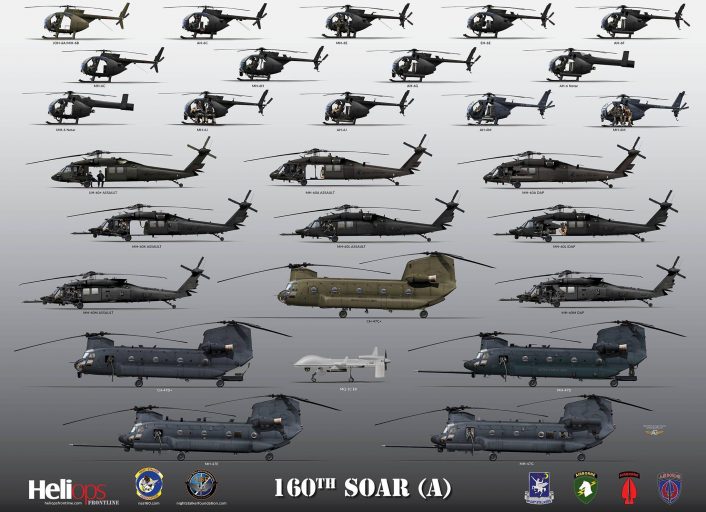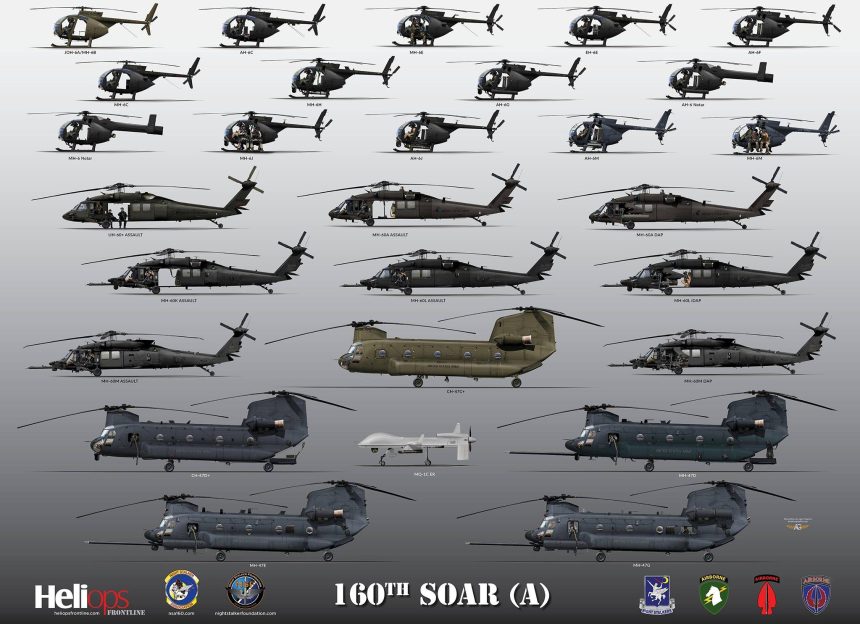A poster finally shows all the variants (except the Stealth Black Hawk) owned by the elite U.S. Army unit.
The U.S. Army 160th Special Operations Aviation Regiment (Airborne) “Night Stalkers” is a highly-specialized combat aviation unit headquartered at Ft. Campbell, Kentucky. The unit supports U.S. and coalition combat units like Army Special Forces, Naval Special Warfare (SEALs) and other special operations units conducting attack, assault, reconnaissance, infiltration and exfiltration, and any kind of known or unknown special operations you may imagine.
Here’s what we wrote about the unit when we published some rare images of the Night Stalkers training in plain daylight close to the Dam Neck Annex of Oceana Naval Air Station, Virginia.
The U.S. Army’s 160th SOAR specializes in night flying at low altitude for clandestine insertions into denied areas. Aircraft flown by the Nightstalkers have an exotic communications and sensor suite on board accounting for the massive number of antennae and vision systems protruding from the helicopters. The MH-60M Blackhawks have a dazzling array of special secure radios, sensors and satellite communications on board. They include the AN/ARC-201D single channel ground and airborne radio system (SINCGARS), four onboard Raytheon AN/ARC-231 Skyfire radios, two of them equipped with satellite communications capability, two AN/ARC-220 high frequency radios, an MTX Blue Force Tracker to prevent accidental friendly fire engagements. The nose of the MH-60M also features the Raytheon AN/APQ-187 SilentKnight radar for terrain-following at low altitude at night and the Raytheon AN/ZSQ-2 EOSS electro-optical (EO) and infrared (FLIR) cameras for night vision. Nightstalker pilots are also the most proficient aviators in the world at dangerous low-altitude, night vision goggle flying.
The “Night Stalkers” operate a variety of assets: the MH-47G Chinooks, MH-60L/M/K Black Hawks and A/MH-6M Little Birds, and, since Nov. 19, 2013, also the MQ-1C Gray Eagle drone, an advanced derivative of the Predator specialized in providing direct operation control by Army field commanders, used to carry out Reconnaissance, Surveillance, and Target Acquisition (RSTA); convoy protection; Improvised Explosive Device (IED) detection as well as able to providing live aerial imagery to ground patrols and to carry PGMs (Precision Guided Munitions).
A brand new poster provides, for the very first time, every single model flown by the Night Stalkers from its origins to the present.

Here’s the list of helicopters (and drones) depicted the in the image with impressive detail.
Little Birds
JOH-6A/MH-6B
AH-6C
AH-6F
AH-6G
AH-6J
MH-6J
AH-6M
EH-6E
MH-6C
MH-6E
MH-6H
AH-6 NOTAR
MH-6 NOTAR
Chinooks
CH-47C+
CH-47D+
MH-47D
MH-47E
MH-47G
Blackhawks
UH-60A+
MH-60A Assault
MH-60A DAP
MH-60K Assault
MH-60L Assault
MH-60L DAP
MH-60M Assault
MH-60M DAP
UCAV
MQ-1C Extended Range “Gray Eagle”
Among the interesting things you can find in the awesome poster there is also a little known NOTAR (NO TAil Rotor) variant of the MH-6J. Two MH-6J airframes were converted to NOTAR configuration (hence these are not MD520N). These hybrid variants were used for transport and attack (with rocket launchers and Minigun) but not fully meeting the operational requirements, they were converted to Little Birds and put back into service as MH-6Js.
Here’s what the Author of the poster, our close friend Ugo Crisponi, told us about the artwork:
To create the artwork of the poster, very accurate drawings were provided to reproduce the aircraft as precisely as possible, with attention to detail at the rivet level! It was a long and intense commitment, lasting months, which involved numerous people who in various capacities provided their experience and expertise. As you can see they are all deliberately reproduced in a static setting. The reason is that it was also necessary to accurately reproduce the rotors and blades, which vary from specimen to specimen. Nothing was left to chance. The end result is truly unique.
The poster was strongly desired by the owner of the New Zealand magazine HeliOps Magazine, Ned Dawson, with whom I have been collaborating for over a decade. The occasion was created by meetings that Ned had with the leaders of the 160th Special Operations Aviation Regiment (Airborne) “NIGHTSTALKERS” based in Fort Campbell, Kentucky and included in the JSOC and contacts with personnel both in active service and thanks to personnel (pilots and technicians) who have worked since the origins of the unit. This is the first time a single artwork includes all the assets flown by the 160th SOAR, including those which have participated in the most risky and “iconic” operations, such as the invasion of Grenada 1983 (“Operation Urgent Fury”), Panama 1989 (“Just Cause”), Battle of Mogasishu in 1993 (“Gothic Serpent”), made famous by Black Hawk Down, and many others.
BTW, someone might notice that one model is missing: the MH-X Stealth Black Hawk that took part in Operation Neptune Spear, the killing of Bin Laden on May 1, 2011. During that raid, the unit flew a classified, low-observable variant of the Blackhawk helicopter that has since been popularly referred to in speculation as the “MH-X Stealth Black Hawk” or “Silent Hawk”. As you will probably remember, as the first images of the remains of one of the helicopters used by the U.S. Navy SEALs in the raid, started to spread through the social media on May 2, 2011, aviation experts and enthusiasts around the world immediately noticed something pretty weird: those parts, didn’t seem to belong to any known type of chopper. Few hours later, on May 3, 2011, this Author was probably the world’s first to write that the helicopter that had crashed in Pakistan had some stealthy features. In fact, I begun studying the possible shape of what the so-called “Stealth Black Hawk” or “Silent Hawk” immediately after the first pictures of the helicopter’s tail section appeared online. With the help of Ugo Crisponi, I imagined what the full stealthy chopper would have looked like after applying the tail section and rotor revealed by the photographs, along with imaginary engine shields, rotor covers, an extra main rotor blade (to slow down the rotor speed making blades quieter) and some imagination. Few days ago, The War Zone published the first picture of heavily modified EH-60 electronic warfare and signals intelligence variant of the Black Hawk that is considered a forerunner of the MH-X used in the OBL raid. Well, if you compare our renderings with the photo, it looks like myself and Ugo were not too far at least from an early version of the stealth chopper.
If you think we made this render, based on almost no detail, on May 5, 2011, 3 days after the raid exposed the existence of a Stealth Black Hawk, it’s at least impressive how close we were to the real thing! https://t.co/tYuu47Lbj8 pic.twitter.com/pv6bWwUcez
— David Cenciotti (@cencio4) August 4, 2020
Books and media accounts suggest only two of the Stealth Black Hawk aircraft were ever produced (and, to be honest, although we have also speculated about the existence of stealthy Little Birds and stealthy Chinooks as well, nothing has ever emerged about these..). Whatever, the Stealth Black Hawk would probably not be included in the artwork anyway: although the MH-X was/is operated by the 160th SOAR (A), based on the unconfirmed information we have received, the stealthy choppers are/were officially assigned to another unit.
Back to the poster, you can order it here. Two logos are visible in the lower part of the artwork, in particular that of the Nightstalker Foundation to which a significant portion of the money raised with the sales of the poster will be donated.









